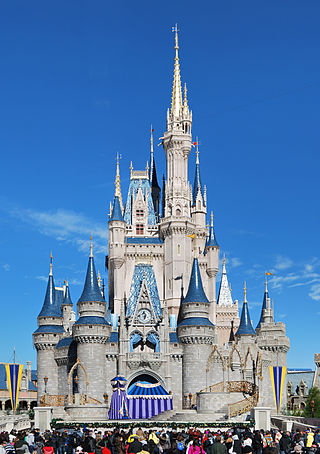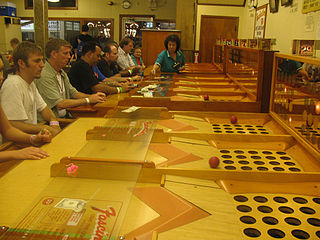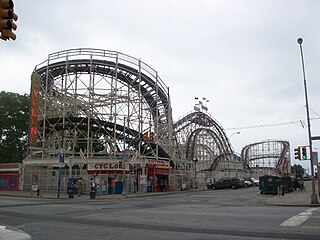
An amusement park is a park that features various attractions, such as rides and games, as well as other events for entertainment purposes. A theme park is a type of amusement park that bases its structures and attractions around a central theme, often featuring multiple areas with different themes. Unlike temporary and mobile funfairs and carnivals, amusement parks are stationary and built for long-lasting operation. They are more elaborate than city parks and playgrounds, usually providing attractions that cater to a variety of age groups. While amusement parks often contain themed areas, theme parks place a heavier focus with more intricately-designed themes that revolve around a particular subject or group of subjects.

A Tumble Bug is an amusement park ride with a circular track.

The Rotor is an amusement ride designed and patented by German engineer Ernst Hoffmeister in 1948. The ride was first demonstrated at Oktoberfest 1949 and still appears in numerous amusement parks. The Rotor is a large, upright barrel, rotated to create an inward acting centripetal force supplied by the wall's support's force. Once at full speed, the floor is retracted, leaving the riders stuck to the wall of the drum.

Fascination is a game commonly found in North American amusement parks, boardwalks and arcades. The game is a redemption game, in that prizes are often won for playing the game. The game dates to 1918, with the first location opening at Coney Island, NY. It became popular during the 1920s and spread quickly from coast to coast, as evidenced in pictures of Chutes at the Beach in San Francisco, a park that operated from 1903 - 1928. Over a century later, there are still a handful of locations that are in operation, mostly in the Northeastern US.
Great Old Amusement Parks is a 1999 PBS television documentary VHS DVD produced by Rick Sebak of WQED Pittsburgh which aired on PBS, on July 21, 1999.

Luna Park was a trolley park in Alexandria County, Virginia that operated between 1906 and 1915. Built as a way to attract business along the trolley line in Alexandria following the closure of nearby racing and gambling establishments, the Washington, Alexandria, and Mount Vernon Electric Railway formed a company that constructed the amusement park for $500,000 in just three months. The park was designed by Frederick Ingersoll, who created similar parks throughout the country around the same time period.

Roller coaster amusement rides have origins back to ice slides constructed in 18th-century Russia. Early technology featured sleds or wheeled carts that were sent down hills of snow reinforced by wooden supports. The technology evolved in the 19th century to feature railroad track using wheeled cars that were securely locked to the track. Newer innovations emerged in the early 20th century with side friction and underfriction technologies to allow for greater speeds and sharper turns. By the mid-to-late 20th century, these elements intensified with the introduction of steel roller coaster designs and the ability to invert riders.

Luna Park was a trolley park in Cleveland, Ohio, USA, from 1905 to 1929.
Frederick Ingersoll was an American inventor, designer, builder and entrepreneur who created the world's first chain of amusement parks and whose manufacturing company built 277 roller coasters, fueling the popularity of trolley parks in the first third of the twentieth century. Some of these parks and roller coasters still exist today.
Electric Park was a name shared by dozens of amusement parks in the United States that were constructed as trolley parks and owned by electric companies and streetcar companies. After 1903, the success of Coney Island inspired a proliferation of parks named Luna Park and Electric Park, while the World's Columbian Exposition of 1893 inspired the formation of White City amusement parks at roughly the same time. The existence of most of these parks was generally brief: the bulk of them closed by 1917, the year of the United States' entry into World War I. Many pavilions have outlasted the parks themselves, with a few of them still standing today.
White City is the common name of dozens of amusement parks in the United States, the United Kingdom, and Australia. Inspired by the White City and Midway Plaisance sections of the World's Columbian Exhibition of 1893, the parks started gaining in popularity in the last few years of the 19th century. After the 1901 Pan-American Exposition inspired the first Luna Park in Coney Island, a frenzy in building amusement parks ensued in the first two decades of the 20th century.
Mayors National Climate Action Agenda, or Climate Mayors, is an association of United States mayors with the stated goal of reducing greenhouse gas emissions. Founded by Los Angeles mayor Eric Garcetti, former Houston mayor Annise Parker, and former Philadelphia mayor Michael Nutter, the group represents 435 cities and nearly 20% of the U.S. population.

Fort George Amusement Park was a trolley park and amusement park that operated in the Washington Heights and Inwood neighborhoods of Upper Manhattan, New York City, in the late 19th and early 20th centuries. It occupied an area between 190th and 192nd Streets east of Amsterdam Avenue, within present-day Highbridge Park.

Frederic Williams Thompson was an American architect, engineer, inventor, and showman known for creating amusement rides and one of the first large amusement parks.












